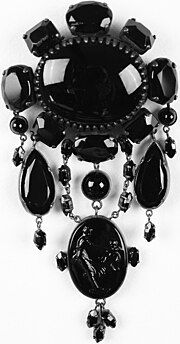Renaissance
The Renaissance and exploration both had significant impacts on the development of jewellery in Europe. By the 17th century, increasing exploration and trade lead to increased availability of a wide variety of gemstones as well as exposure to the art of other cultures. Whereas prior to this the working of gold and precious metal had been at the forefront of jewellery, this period saw increasing dominance of gemstones and their settings. A fascinating example of this is the Cheapside Hoard, the stock of a jeweller hidden in London England during the Commonwealth period and not found again until 1912. It contained Colombian emerald, topaz, amazonite from Brazil, spinel, iolite, and chrysoberyl from Sri Lanka, ruby from India, Afghani lapis lazuli, Persian turquoise, Red Sea peridot, as well as Bohemian and Hungarian opal, garnet, and amethyst. Large stones were frequently set in box-bezels on enamelled rings. Notable among merchants of the period was Jean-Baptiste Tavernier, who in the 1660s brought the precursor stone of the Hope Diamond to France.
When Napoleon Bonaparte was crowned as Emperor of the French in 1804, he revived the style and grandeur of jewellery and fashion in France. Under Napoleon’s rule, jewellers introduced parures, suites of matching jewellery, such as a diamond tiara, diamond earrings, diamond rings, a diamond brooch and a diamond necklace. Both of Napoleon’s wives had beautiful sets such as these and wore them regularly. Another fashion trend resurrected by Napoleon was the cameo. Soon after his cameo decorated crown was seen, cameos were highly sought after. The period also saw the early stages of costume jewellery, with fish scale covered glass beads in place of pearls or conch shell cameos instead of stone cameos. New terms were coined to differentiate the arts: jewellers who worked in cheaper materials were called bijoutiers, while jewellers who worked with expensive materials were called joailliers; a practice which continues to this day.
Romanticism
Starting in the late 18th century, Romanticism had a profound impact on the development of western jewellery. Perhaps the most significant influences were the public’s fascination with the treasures being discovered through the birth of modern archaeology, and the fascination with Medieval and Renaissance art. Changing social conditions and the onset of the industrial revolution also lead to growth of a middle class that wanted and could afford jewellery. As a result, the use of industrial processes, cheaper alloys, and stone substitutes, lead to the development of paste or costume jewellery. Distinguished goldsmiths continued to flourish, however, as wealthier patrons sought to ensure that what they wore still stood apart from the jewellery of the masses, not only through use of precious metals and stones but also though superior artistic and technical work; one such artist was the French goldsmith Françoise Désire Fromment Meurice. A category unique to this period and quite appropriate to the philosophy of romanticism was mourning jewellery. It originated in England, where Queen Victoria was often seen wearing jet jewellery after the death of Prince Albert; and allowed the wearer to continue wearing jewellery while expressing a state of mourning at the death of a loved one.
In the United states, this period saw the founding in 1837 of Tiffany & Co. by Charles Lewis Tiffany. Tiffany's put the United States on the world map in terms of jewellery, and gained fame creating dazzling commissions for people such as the wife of Abraham Lincoln; later it would gain popular notoriety as the setting of the film Breakfast at Tiffany's. In France, Pierre Cartier founded Cartier SA in 1847, while 1884 saw the founding of Bulgari in Italy. The modern production studio had been born; a step away from the former dominance of individual craftsmen and patronage.
This period also saw the first major collaboration between East and West; collaboration in Pforzheim between German and Japanese artists lead to Shakudo plaques set into Filigree frames being created by the Stoeffler firm in 1885). Perhaps the grand finalé – and an appropriate transition to the following period – were the masterful creations of the Russian artist Peter Carl Fabergé, working for the Imperial Russian court, whose Fabergé eggs and jewellery pieces are still considered as the epitome of the goldsmith’s art.

No comments:
Post a Comment